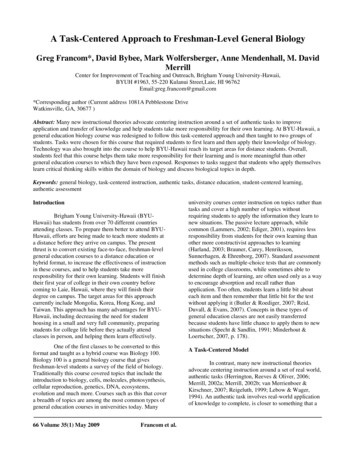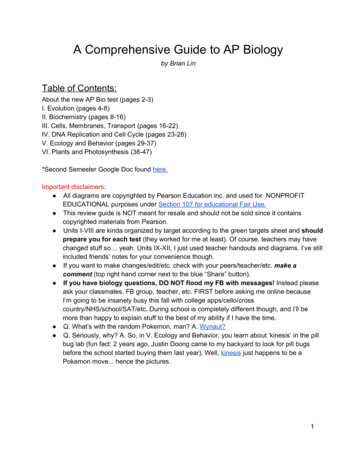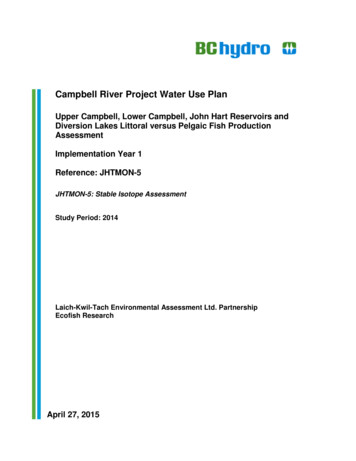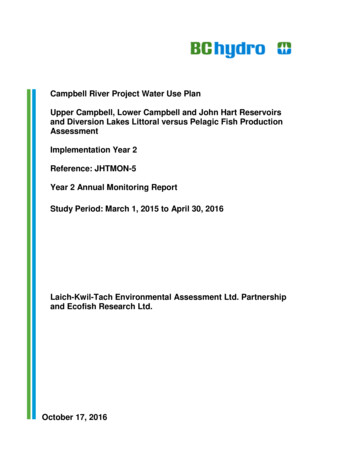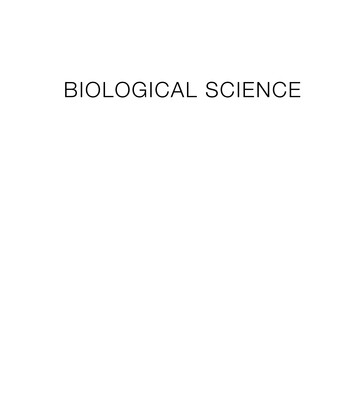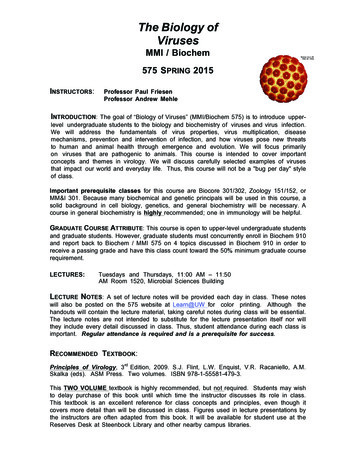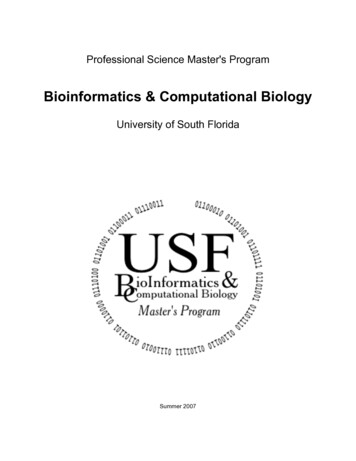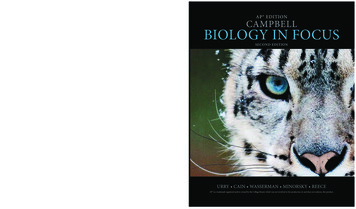
Transcription
AP EDITIONCampbell Biology in Focus AP Edition was designed to match the CollegeBoard’s AP Biology Curriculum Framework. The textbook combined withMasteringBiology provides AP teachers and students with an effective andengaging learning environment.URRYCAINWASSERMANMINORSKYREECEis the most effective and powerful online sciencetutorial, homework, and assessment system available. Below are some of itsmany features.Students can access the MasteringBiology Study Area for use on their own or in a group. Within the Study Areastudents can explore the most difficult biology topics, reinforced using tutorials, quizzes, and more with BioFlix 3-D Animations, Get Ready for Biology, Cumulative Tests, Videos, Activities, Investigations, Lab Bench,Audio Glossary, Word Roots, Key Terms, Flashcards, and Art. Also in the Study Area are Practice Tests to helpstudents assess their understanding of each chapter, providing feedback for right and wrong answers.Interpret the Data Questions throughout the text ask students to analyze a graph, figure, or table. Solve ItTutorials engage students in a multistep investigation of a “mystery” or open question in which they must analyzereal data. These features, which are assignable in MasteringBiology , reinforce Science Practices 4, 5, and 6 from theCollege Board’s Curriculum Framework.Highly interactive, self-paced MasteringBiology tutorials assist students with hints and feedback specific to theirmisconceptions. Correlated to the textbook, these tutorials provide personalized coaching and feedback on thetoughest topics in the course.AP Exam-style Practice Questions that test student mastery of the AP Biology Curriculum Framework’sLearning Objectives with their companion Science Practices are assignable in MasteringBiology and availableon ExamView CD.The MasteringBiology gradebook provides progress monitoring tools that give quick results and easy-tointerpret insights into student performance. Every assignment is automatically graded, and shades of redhighlight vulnerable students and challenging assignments. With a single click, reporting tools summarizethe most difficult problems, grade distribution, and even score improvement over the curve.Teacher and student access to MasteringBiology is provided with the purchase of the textbook. See page xxviii formore information.Please visit us at www.PearsonSchool.com/Advanced for more information.To order any of our products, contact our customer service department at (800) 848-9500.ISBN-13: 978-0-13-427891-9ISBN-10:0-13-427891-7AP is a trademark registered and/or owned by the College Board, which wasnot involved in the production of, and does not endorse, this product.9 0 0 0 0BIOLOGY IN FOCUSsecond editionCAMPBELLScientific Skills Exercises in every chapter use real data to build key skills needed for students to master theScience Practices of the AP Biology Curriculum Framework, including data analysis, graphing, experimentaldesign, and math skills. These exercises have assignable, interactive versions in MasteringBiology that areautomatically graded.CAMPBELLBIOLOGY IN FOCUSThe Pearson eText gives students access to the text whenever and wherever they can access the Internet,including access on iPad and Android devices via the Pearson eText app. This app provides the same featuresavailable to browser-based Mastering with Pearson eText subscribers: full-text search, highlighting, note-taking,bookmarking, and glossaries. Plus, students can download chapters to work offline.AP EDITIONsecondedition9780134 278919URRY CAIN WASSERMAN MINORSKY REECEAP is a trademark registered and/or owned by the College Board, which was not involved in the production of, and does not endorse, this product.
Editor-in-Chief: Beth WilburExecutive Editor: Josh FrostExecutive Editorial Manager: Ginnie Simione JutsonSupervising Editors: Beth N. Winickoff and Pat BurnerSenior Developmental Editors: John Burner and Mary Ann MurrayDevelopmental Artist: Andrew Recher, LachinaEditorial Assistant: Alexander HelmintollerDevelopmental Editors, AP Edition: Mary Hill and Jennifer AngelDirector, AP & Electives Product Management/Marketing:Elaine ShemaMarketing Manager, AP & Electives: Michele MirabelliCurriculum Consultant: Robin HeydenProgram Manager: Leata HollowayProject Manager: Lori NewmanProduction Management and Composition: S4Carlisle PublishingServicesIllustrations: LachinaDesign Manager: Marilyn PerryCover and Text Design: Hespenheide DesignRights & Permissions Manager: Rachel YoudelmanPhoto Permissions Project Manager: Donna KalalPhoto Researcher: Maureen SpuhlerPhoto Permissions Specialist: Lumina DatamaticsText Permissions Project Manager: Tim NichollsText Permissions Specialist: Lumina DatamaticsDirector of Content Development, MasteringBiology :Natania MlawerSenior Developmental Editor, MasteringBiology : Sarah JensenSenior Editorial Content Producer: Lee Ann DoctorExecutive Mastering Media Producer: Katie FoleyAssociate Mastering Media Producer: Charles HallDirector of Marketing: Christy LeskoExecutive Marketing Manager: Lauren HarpSenior Marketing Manager: Amee MosleyManufacturing Buyer: Stacey WeinbergerText Printer: Courier/KendallvilleCover Printer: Phoenix Color/HagerstownCover Photo Credit: Klaus Honal/AGE FotostockCopyright 2017, 2014 Pearson Education, Inc. All Rights Reserved. Printed in the United States of America.This publication is protected by copyright, and permission should be obtained from the publisher prior to anyprohibited reproduction, storage in a retrieval system, or transmission in any form or by any means, electronic,mechanical, photocopying, recording, or otherwise. For information regarding permissions, request forms andthe appropriate contacts within the Pearson Education Global Rights & Permissions department, please visitwww.pearsoned.com/permissions/.Readers may view, browse, and/or download material for temporary copying purposes only, provided theseuses are for noncommercial personal purposes. Except as provided by law, this material may not be further reproduced, distributed, transmitted, modified, adapted, performed, displayed, published, or sold in whole orin part, without prior written permission from the publisher.Acknowledgments of third-party content start on page CR-1, constituting an extension of this copyright page.PEARSON, ALWAYS LEARNING, MasteringBiology and BioFlix are exclusive trademarks owned by PearsonEducation, Inc. or its affiliates in the U.S. and/or other countries.AP and Advanced Placement Program are trademarks registered and/or owned by the College Board, whichwas not involved in the production of, and does not endorse, this product.Unless otherwise indicated herein, any third-party trademarks that may appear in this work are the property oftheir respective owners and any references to third-party trademarks, logos or other trade dress are for demonstrative or descriptive purposes only. Such references are not intended to imply any sponsorship, endorsement,authorization, or promotion of Pearson’s products by the owners of such marks, or any relationship betweenthe owner and Pearson Education, Inc. or its affiliates, authors, licensees, or distributors.Library of Congress Cataloging-in-Publication DataCampbell biology in focus. – Second edition / Lisa A. Urry, Michael L. Cain, Steve A. Wasserman,and Peter V. Minorsky.pages cmIncludes index.ISBN 978-0-321-96275-1ISBN 0-321-96275-31. Biology. I. Urry, Lisa A. II. Cain, Michael L. (Michael Lee), 1956- III. Wasserman, Steven Alexander IV.Minorsky, Peter V. V. Title: Biology in focus.QH308.2C347 2016570—dc232015005641ISBN 10: 0-13-427891-7 (High School Binding)ISBN 13: 978-0-13-427891-9 (High School Binding)1 2 3 4 5 6 7 8 9 10—V311—20 19 18 17 16www.PearsonSchool.com/AdvancedURRY8919 02 FM FINAL.indd 1# 153397 Cust: Pearson / BC Au: Urry Pg. No. iTitle: Campbell Biology in Focus, 2eC/M/Y/KShort / Normal / LongDESIGN SERVICES OFS4carlislePublishing Services15/10/15 1:44 PM
Brief Contents1Introduction: Evolution andthe Foundations of Biology 2UNIT 4 The EvolutionaryHistory of LifeUNIT 1 Chemistry and Cells2423Early Life and the Diversificationof Prokaryotes 47425The Origin and Diversificationof Eukaryotes 4972627The Colonization of Land 520The Chemical Context of Life 22Carbon and the Molecular Diversityof Life 4345A Tour of the Cell 7267An Introduction to Metabolism 12289Photosynthesis 161Membrane Transport and CellSignaling 100Cellular Respiration andFermentation 141The Cell Cycle 182UNIT 2 GeneticsThe Rise of Animal Diversity 545UNIT 5 Plant Form and Function2829Plant Structure and Growth 57530Reproduction and Domestication ofFlowering Plants 61931Plant Responses to Internal and ExternalSignals 639Resource Acquisition, Nutrition, andTransport in Vascular Plants 593101112Meiosis and Sexual Life Cycles 200The Chromosomal Basis ofInheritance 236321314The Molecular Basis of Inheritance 253The Internal Environment of Animals:Organization and Regulation 663Animal Nutrition 6881516Regulation of Gene Expression 3031718Viruses 34233343536373839Mendel and the Gene Idea 214Gene Expression: From Gene toProtein 278Development, Stem Cells,and Cancer 321Genomes and Their Evolution 357UNIT 3 Evolution1920212223Descent with Modification 379Phylogeny 395The Evolution of Populations 413The Origin of Species 434Broad Patterns of Evolution 452UNIT 6 Animal Form and FunctionCirculation and Gas Exchange 706The Immune System 733Reproduction and Development 751Neurons, Synapses, and Signaling 772Nervous and Sensory Systems 790Motor Mechanisms and Behavior 814UNIT 7 Ecology40Population Ecology and the Distributionof Organisms 840414243Species Interactions 867Ecosystems and Energy 886Global Ecology and ConservationBiology 906ii B r i e f C o n t e n t sURRY8919 02 FM FINAL.indd 2# 153397 Cust: Pearson / BC Au: Urry Pg. No. iiTitle: Campbell Biology in Focus, 2eC/M/Y/KShort / Normal / LongDESIGN SERVICES OFS4carlislePublishing Services14/10/15 3:44 PM
PrefaceThe snow leopard (Panthera uncia) that peers intentlyfrom the cover of this book has a suite of evolutionary adaptations that enable it to spot, track, and ambush itsprey. The snow leopard’s keen eye is a metaphor for our goalin writing this text: to focus with high intensity on the coreconcepts and scientific skills AP Biology students need tosucceed.The current explosion of biological information, whileexhilarating in its scope, poses a significant challenge—how best to teach a subject that is constantly expanding itsboundaries. In particular, instructors have become increasingly concerned that their students are overwhelmed by agrowing volume of detail and are losing sight of the big ideasin biology. In response to this challenge, various groups ofbiologists have initiated efforts to refine and in some casesredesign the introductory college biology course. In particular, the report Vision and Change in Undergraduate Biology Education: A Call to Action* advocates focusingcourse material and instruction on key ideas while transforming the classroom through active learning and scientificinquiry. Similarly, the College Board’s Advanced Placementprogram, in conjunction with the National Science Foundation, undertook a revision of the AP Biology program.In 2011, the College Board published the new AP BiologyFramework, which ensures the right breadth of contentcoverage so teachers and students have time to focus on developing and practicing the scientific inquiry and reasoningskills so crucial to future careers in science.We were inspired by these ongoing changes in biologyeducation to write the first edition of Campbell BIOLOGYIN FOCUS, AP Edition, a new,shorter textbook that was received with widespread excitement by instructors. Guided bytheir feedback, we honed theSecond Edition so that it does aneven better job of helping students explore the key questions, approaches, andideas of modernbiology.New to This EditionHere we briefly describe the new features that we have developed for the Second Edition, but we invite you to explorepages xvi–xxix for more information and examples.New in the Text The impact of genomics across biology is explored throughout the Second Edition with examples that reveal how ourability to rapidly sequence DNA and proteins on a massivescale is transforming all areas of biology, from molecular andcell biology to phylogenetics, physiology, and ecology. Illustrative examples are distributed throughout the text.The Second Edition provides increased coverage of the urgent issue of global climate change. Starting with a new figure (Figure 1.11) and discussion in Chapter 1 and concluding with significantly expanded material on causes and effects of climate change in Chapter 43, including a new MakeConnections Figure (Figure 43.28), the text explores the impact of climate change at all levels of the biological hierarchy.AP Icons throughout the text highlight connections tothe College Board’s Curriculum Framework for AP Biology.AP Big Ideas included at the beginning of each chapterhelp students link the chapter concepts to the Framework’sfour Big Ideas.AP Make Connections Figures pull together contentfrom different chapters, providing a visual representation of“big picture” relationships, helping students to connect andrelate knowledge across domains.Interpret the Data Questions throughout the text engagestudents in scientific inquiry by asking them to analyze datapresented in a graph, figure, or table. The Interpret the DataQuestions can be assigned and automatically graded inMasteringBiology. Synthesize Your Knowledge Questions at the end of eachchapter ask students to synthesize the material in the chapter and demonstrate their big-picture understanding.Scannable QR codes and URLs at the end of every chaptergive students quick access to Vocabulary Self-Quizzesand Practice Tests that students can use on a smartphone, tablet, or computer.Detailed information about the organization of the textand new content in the Second Edition is provided onpages vi–ix, following this Preface.* Copyright 2011 American Association for the Advancement of Science. See also V isionand Change in Undergraduate Biology Education: Chronicling Change, Inspiring the Future, copyright 2015 American Association for the Advancement of Science. For moreinformation, see www.visionandchange.orgP r e f ac e iiiURRY8919 02 FM FINAL.indd 3# 153397 Cust: Pearson / BC Au: Urry Pg. No. iiiTitle: Campbell Biology in Focus, 2eC/M/Y/KShort / Normal / LongDESIGN SERVICES OFS4carlislePublishing Services14/10/15 3:44 PM
New inEvolution is the unifying idea of Chapter 1, Introduction:Evolution and the Foundations of Biology, which devotes Concept 1.2 to the core theme of evolution, providingstudents with a foundation in evolution early in their study. Following the in-depth coverage of evolutionary mechanisms in Unit 3, evolution also provides the storyline forthe novel approach to presenting biological diversity inUnit 4, The Evolutionary History of Life. Focusing onlandmark events in the history of life, Unit 4 highlightshow key adaptations arose within groups of organismsand how evolutionary events led to today’s diversity of life. Ready-to-Go Teaching Modules in the Instructor Resources area help instructors efficiently make use of theavailable teaching tools for many key topics. Before-classassignments, in-class activities, and after-class assignmentsare provided for ease of use. AP Exam-style Practice Questions test student masteryof the Framework’s Learning Objectives and their companion Science Practices. These questions are assignable inMasteringBiology. MasteringBiology Tutorials extend the power ofMasteringBiology: Interpret the Data Questions ask students to analyze agraph, figure, or table. Solve It Tutorials engage students in a multistep investigation of a “mystery” or open question in which theymust analyze real data. HHMI Short Films, documentary-quality movies fromthe Howard Hughes Medical Institute, engage studentsin topics from the discovery of the double helix to evolution, with assignable questions. Our Guiding PrinciplesOur key objective in creating Campbell BIOLOGY INFOCUS, AP Edition, was to produce a shorter text by streamlining selected material, while emphasizing conceptual understanding and maintaining clarity, proper pacing, and rigor.Here, briefly, are the five guiding principles of our approach:1. Focus on Core ConceptsWe developed this text to help AP students master the fundamental content and scientific skills necessary for successon the AP Exam. In structuring the text, we were guided bydiscussions with biology professors across the country, analysis of hundreds of syllabi, study of the debates in the literatureof scientific pedagogy, and our experience as instructors at arange of institutions. The result is a briefer book, crafted toaddress the AP Biology curriculum, that informs, engages,and inspires.2. Establish Evolution as the Foundation of BiologyEvolution is the central theme of all biology, and it is the coretheme of this text, as exemplified by the various ways thatevolution is integrated into the text:Every chapter explicitly addresses the topic of evolutionthrough an Evolution section that leads students to consider the material in the context of natural selection andadaptation. Each Chapter Review includes a Connect to Big Idea 1Question that asks students to think critically about howan aspect of the chapter relates to evolution. 3. Engage Students in Scientific ThinkingHelping students learn to “think like a scientist” is a primarygoal of AP Biology. Students need to understand how to formulate and test hypotheses, design experiments, and interpret data. Scientific thinking and data interpretation skills toplists of learning outcomes and foundational skills desired forstudents entering higher-level courses. The Second Editionof Campbell BIOLOGY IN FOCUS, AP Edition, meets thisneed in several ways:Scientific Skills Exercises in every chapter are correlatedto the Framework’s Science Practices. Using real data, students will build skills, including data analysis, graphing, experimental design, and math skills. These exercises can alsobe assigned and automatically graded in MasteringBiology. New Interpret the Data Questions ask students to analyze a graph, figure, or table. These questions are also assignable in MasteringBiology. Scientific Inquiry Questions in the end-of-chapter material give students further opportunity to master SciencePractices. Inquiry Figures and Research Method Figures revealhow we know what we know and model the process of scientific inquiry. 4. Use Outstanding Pedagogy to Aid LearningCampbell BIOLOGY IN FOCUS, AP Edition, builds on ourhallmarks of clear and engaging text and superior pedagogyto promote student learning:In each chapter, a framework of carefully selected KeyConcepts helps students distinguish the “forest” from the“trees.” These Key Concepts focus on the Big Ideas andprovide a context for the supporting details. Questions throughout the text catalyze learning by encouraging students to actively engage with and synthesizekey material. Active learning questions include ConceptCheck Questions, Make Connections Questions, What If?Questions, Figure Legend Questions, Draw It Exercises,Summary Questions, and the new Synthesize Your Knowledge and Interpret the Data Questions. iv P r e f ac eURRY8919 02 FM FINAL.indd 4# 153397 Cust: Pearson / BC Au: Urry Pg. No. ivTitle: Campbell Biology in Focus, 2eC/M/Y/KShort / Normal / LongDESIGN SERVICES OFS4carlislePublishing Services14/10/15 3:44 PM
Test Your Understanding Questions at the end of eachchapter are presented in standard AP Exam format and areorganized into three levels based on Bloom’s Taxonomy. 5. Create Art and Animations That TeachBiology is a visual science, and students learn from the art asmuch as the text. Therefore, we have developed our art and animations to teach with clarity and focus. Here are some of theways our art and animations serve as superior teaching tools: The new Make Connections Figures help students makeimportant connections across units, across levels of organization, and across the Framework’s Big Ideas.Each unit in Campbell BIOLOGY IN FOCUS, AP Edition,opens with a visual preview that tells the story of the chapters’ contents, showing how the material in the unit fits intoa larger context.BioFlix 3-D Animations help students visualize biology with movie-quality animations that can be shown inclass and reviewed by students in the Study Area. BioFlix Tutorials use the animations as a jumping-off point forMasteringBiology coaching assignments with feedback.By integrating text, art, and photos, Exploring Figures helpstudents access information efficiently.Guided Tour Figures use descriptions in blue type towalk students through complex figures as an instructorwould, pointing out key structures, functions, and steps ofprocesses.Because text and illustrations are equally important forlearning biology, the page layouts are carefully designed toplace figures together with their discussions in the text.PowerPoint slides are painstakingly developed for optimumpresentation in classrooms, with enlarged editable labels, artbroken into steps, and links to animations and videos.Many Tutorials and Activities in MasteringBiology integrateart from the text, providing a unified learning experience.MasteringBiology is the most widely used online assessmentand tutorial program for biology, providing an extensive library of homework assignments that are graded automatically.Self-paced tutorials provide individualized coaching withspecific hints and feedback on the most difficult topics inthe course. In addition to the new tutorials already mentioned,MasteringBiology includes hundreds of online exercises thatcan be assigned. For example:The Scientific Skills Exercises from the text can be assigned and automatically graded in MasteringBiology. BioFlix Tutorials use 3-D animations to help studentsmaster tough topics. Make Connections Tutorials help students connect whatthey are learning in one chapter with material they havelearned in another chapter. BLAST Data Analysis Tutorials teach students how towork with real data from the BLAST database.Experimental Inquiry Tutorials allow students to replicate a classic biology experiment and learn the conceptualaspects of experimental design.Reading Quiz Questions and approximately 3,000Test Bank Questions are available for assignment.AP Exam-style Practice Questions that test student mastery of the Framework’s Learning Objectives and their companion Science Practices are assignable in MasteringBiology.Optional Adaptive Follow-up Assignments are based oneach student’s performance on the original Mastering Biologyassignment and provide additional coaching and practice.Every assignment is automatically graded and entered into agradebook. Instructors can check the gradebook to see whattopics students are struggling with and then address thosetopics in class.MasteringBiology and the text work together to providean unparalleled learning experience. For more informationabout MasteringBiology and to explore additional resourcesit provides, see pages xxiv–xxix.AP Advisory GroupMany expert reviewers (listed in the college edition) contributed to this textbook. In addition, an Advisory Group of experienced teachers provided valuable advice for the AP Edition:Jean DeSaix, University of North Carolina, Chapel HillFred Holtzclaw, The Webb School of KnoxvilleTheresa Holtzclaw, The Webb School of KnoxvilleMike Judge, Sacred Heart SchoolsRachel Kalish, San Rafael High SchoolJack Kay, Iolani SchoolNancy Monson, West Linn High SchoolNancy Ramos, Northside Health Careers High SchoolPeggy O’Neill Skinner, The Bush SchoolDiane Sweeney, Sacred Heart SchoolsBrad Williamson, University of KansasOur overall goal in developing and revising this text was toassist instructors and students in their exploration of biologyby emphasizing essential content and skills while maintaining rigor. Although this Second Edition is now completed,we recognize that Campbell BIOLOGY IN FOCUS,AP Edition, like its subject, will evolve. As its authors, weare eager to hear your thoughts, questions, comments, andsuggestions for improvement. We are counting on you—ourteaching colleagues and all students using this book—to provide us with this feedback, and we encourage you to contactus by e-mail:Lisa Urry (Chapter 1, Units 1 and 2): lurry@mills.eduMichael Cain (Units 3, 4, and 7): mcain@bowdoin.eduPeter Minorsky (Unit 5): pminorsky@mercy.eduSteven Wasserman (Unit 6): stevenw@ucsd.eduJane Reece: janereece@cal.berkeley.eduP r e f a c e vURRY8919 02 FM FINAL.indd 5# 153397 Cust: Pearson / BC Au: Urry Pg. No. vTitle: Campbell Biology in Focus, 2eC/M/Y/KShort / Normal / LongDESIGN SERVICES OFS4carlislePublishing Services15/10/15 7:19 PM
Organization and New ContentCampbell BIOLOGY IN FOCUS, AP Edition, is organized intoan introductory chapter and seven units that cover core concepts of biology at a thoughtful pace. When we adaptedCampbell BIOLOGY to write the first edition of this text, wemade informed choices about how to design each chapter tomeet the needs of teachers and students. In some chapters, weretained most of the material; in other chapters, we prunedmaterial; and in still others, we completely reconfigured thematerial. In creating the Second Edition, we solicited feedbackfrom reviewers and used their thoughtful critiques to furtherfine-tune the content and pedagogy. We have also updated thecontent wherever appropriate, and in a few cases reintroducedmaterial. Here, we present synopses of the seven units andhighlight the major revisions made to the Second Edition of Campbell BIOLOGY IN FOCUS, AP Edition.CHAPTER 1 Introduction:Evolution and the Foundationsof BiologyChapter 1 introduces the five biological themes woventhroughout the text:the core theme of Evolution, togetherwith Organization, Information,Energy and Matter, and Interactions.Chapter 1 also explores the processof scientific inquiry through a casestudy describing experiments on theevolution of coat color in the beachmouse. The chapter concludes with adiscussion of the importance of diversity within the scientificcommunity.In the Second Edition, a new figure (Figure 1.8) ongene expression uses lens cells in the eye as an example ofDNA RNA protein and introduces the terms transcription and translation. This new figure and text equipstudents from the outset with an understanding of how genesequences determine an organism’s characteristics. Newtext and a new photo (Figure 1.11) inform students aboutthe effects of climate change in general, and global warmingin particular, on species survival and diversity. Concept 1.3has been thoroughly revised to more realistically reflectthe process of science. A new section has been added onthe Flexibility of the Scientific Process, accompanied by anew Figure 1.19 that depicts the more realistic and complex process of science. The text now discusses searching the scientific literature, and a new question in the Chapter Reviewasks students to use PubMed.UNIT 1 Chemistry and CellsA succinct, two-chapter treatment ofbasic chemistry (Chapters 2 and 3)provides the foundation for this unitfocused on cell structure and function.The related topics of cell membranesand cell signaling are consolidatedinto one c hapter (Chapter 5). Due tothe importance of the fundamentalconcepts in Units 1 and 2, much of thematerial in the rest of these two units has been retainedfrom Campbell BIOLOGY.For the Second Edition, a new table has been added to Chapter 2 detailing the elements in the human body, with anassociated Interpret the Data q uestion. Chapter 3 includesa new section on isomers, with an accompanying figure(Figure 3.5), and ends with a new Concept 3.7 that includescutting-edge coverage of DNA sequencing and introduces genomics and proteomics, as well as bioinformatics. A newMake Connections Figure ( Figure 3.30) entitled “ Contributionsof Genomics and Proteomics to B iology” provides an overview of areas in which genomics and proteomics have hadsignificant impacts—including evolution, conservation biology, paleontology, medical science, and s pecies interactions—withthe aim of inspiring and motivating students. A striking photoof thermophilic cyanobacteria has been added to Figure 6.16on environmental factors affecting enzyme activity. In Chapter 7, a computer model of ATP synthase has been addedto Figure 7.13. The icon for this enzyme in Chapters 7 and 8 hasbeen re-drawn to more closely represent its structure. A newMake Connections Figure (Figure 8.20, “The Working Cell”)integrates all the cellular activities covered in Chapters 3–8 inthe context of a single working plant cell.UNIT 2 GeneticsTopics in this unit include meiosisand classical genetics as well as thechromosomal and molecular basisfor g enetics and gene expression( Chapters 10–14). We also includea chapter on the regulation of gene expression (Chapter 15) and one onthe role of gene regulation in development, stem cells, and cancervi OR G A NI Z A TION A N D NE W C ONTENTURRY8919 02 FM FINAL.indd 6# 153397 Cust: Pearson / BC Au: Urry Pg. No. viTitle: Campbell Biology in Focus, 2eC/M/Y/KShort / Normal / LongDESIGN SERVICES OFS4carlislePublishing Services14/10/15 3:44 PM
(Chapter 16). Methods in biotechnology are integrated intoappropriate chapters. The stand-alone chapter on viruses(Chapter 17) can be taught at any point in the course. Thefinal chapter in the unit, on genome evolution (Chapter 18),provides both a capstone for the study of genetics and abridge to the evolution unit.Chapter 10 of the Second Edition includes a new sectionon “Crossing Over and Synapsis During Prophase I” thatexplains the events of prophase I in mo
Campbell Biology in Focus AP Edition was designed to match the College Board’s AP Biology Curriculum Framework. The textbook combined with MasteringBiology provides AP teachers and students with an effective and engaging learning environment. is the most effective and powerful online sci


